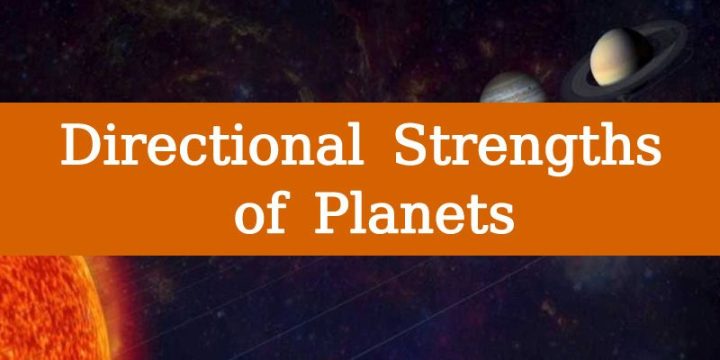Directional Strengths or Digbala of Planets
Digbala of planets refers to the disha or direction of planets and the additional strength they acquire based on certain dishas in space or house in your birth chart. Digbala of planets is an important aspect of astrology. It indicates the directions or houses in which planets are most potent. Analysing and understanding the digbala of planets helps you realise which positions offer almost double strength to planets, making it a very important field. The birth planet or ascendant denotes the East direction in any horoscope. JupiterDigbala and MercuryDigbala can be witnessed here because they are exceptionally powerful in these positions. In all horoscopes, the 10th house from the ascendant represents the South direction. Here we can witness Mars Digbala and Sun Digbala becoming very strong and having their directional strength in this area. Similarly, the 7th house in any horoscope represents West, and we see that, in this direction, Saturn becomes powerful and gains directional strength.Get Your Saturn Transit Predictions
The respective planets in the opposite houses shown above will lose their directional strength when the planets in this house gain digbala. Planetary strength according to time: Moon, Mars and Saturn are powerful during nights while Mercury is always powerful. SunDigbala, Jupiter Digbala and Venus Digbala can be seen during the daytime.
Get to Know About Jupiter Transit
Considering the general strength of planets (from strongest to weakest), we can state that the order of power goes thus – Sun, Moon, Venus, Jupiter, Mercury, Mars & Saturn. Further, the shadow planets Rahu and Ketu give results according to the houses they occupy and their lords. Rahu digbala will, therefore, be consequent to the house it occupies.Know How Rahu-Ketu transits affects you !
Combustion of Planets – Vedic Astrology
One of the important aspects of analysis is the combustion of planets in Vedic astrology. If a planet is within 5 degrees of the Sun, it is considered combustible. If it is within 20 degrees, it is in ordinary combustion. If the planet is within 15 degrees, it is in nominal combustion. Planets in combustion give malefic results, and we should be careful to not alienate them as far as possible.Planetary Natures
As a detailed and ancient science, astrology has taken a lot of aspects into consideration. One of the important elements here is planetary nature. You need to be aware of the nature of different planets and understand how they can affect you if you wish to be successful in life and safe from malefic aspects. Sun, Jupiter, and Moon are divine planets with Saatwika characters. Venus and Mercury are Rajasa by nature. Mars, Saturn, Rahu and Ketu are Thamasa or dark and gloomy. The nature of planets also indicates how they will react in certain situations. It is important to know these aspects as they can have a major impact on how you lead your lives or attain success.36 Limbs of Human body
The human body is extensively ruled by astrology and planets. Suppose you know the exact features and aspects of this science. In that case, you will optimize your body and ensure that it remains healthy and safe over the years. A zodiac sign, or Rasi of 30 degrees, is divided into three Drekkanas (Decante) of 10 degrees each. So in total, there are 36 Drekkanas spread over the 12 Rasis. The limbs and organs of the human body are associated with these Drekkanas, as given in the following table.| Rasi No. | First Drekkana | Second Drekkana | Third Drekkana |
| 1 | Head | Neck | Pelvis |
| 2 | Right Eye | Right Shoulder | Generative Organ |
| 3 | Right Ear | Right Arm | Right Testicle |
| 4 | Right Nostril | Right Side | Right Thigh |
| 5 | Right Cheek | Right Heart | Right Knee |
| 6 | Right Jaw | Right Chest | Right Calf |
| 7 | Mouth | Navel | Legs |
| 8 | Left Jaw | Left Chest | Left Calf |
| 9 | Left Cheek | Left Heart | Left Knee |
| 10 | Left Nostril | Left Side | Left Thigh |
| 11 | Left Ear | Left Arm | Left Testicle |
| 12 | Left Eye | Left Shoulder | Arms |









Mere dil main jo ladke hain use shadi hoge ??
Hi, Finding the right person to share your life is of great importance. Get marriage horoscope to know about your bride/groom, favourable periods to marry, Manglik check and gives remedies to the doshas if any. https://www.clickastro.com/marriage-horoscope
Hi, Finding the right person to share your life is of great importance. Get marriage horoscope to know about your bride/groom, favourable periods to marry, Manglik check and gives remedies to the doshas if any. https://www.clickastro.com/marriage-horoscope
Sir my daughter born on 19 November 2014 and second daughter born on 21 January 2016.today 12April 2019 what time is good for ear piercing.
Hi my daughter was born on 12th of December 2018 please suggest me the good dates in April month 2019 for ear pricing
My son S.R jeeva born in 1-4-2008 and S.R kirthiva in 18-10-2010. Kindly give the auspicious date and time for ear piercing. Give dates upto may 20 bec of summer holidays
Very useful information. For hassle-free wedding planning and venue booking visit https://bigfday.com/
I will have a love marriage or arrange marriage?
Hi, Please get your FREE Marriage Horoscope and find your predictions
https://www.clickastro.com/free-marriage-predictions?ref=cablog
Hi my daughter born on 23 June 2018,5:56pm I am planning to do ear piercing,pls suggest me ,what time is good,which month? thank you
My daughter DOB is 29th January 2015. I would like to know the best dates for ear piercing starting from August of this year.
Hello
My daughter born on 22-03-2019 @ 7.19AM, Davangere Karnataka
Please advise me auspicious day for ear piercing for my child
Thank you in advance
My child was born on 4 oct 2017 what is auspicikis time in 2019 for ear piercing
My son was born on September 8, 2018. kindly suggest ear piercing date in July and August. ….thank you
My baby girl is 1 year 9 months born on 26th November 2017 coorg Karnataka india which are the gud days in this month of May 2019
Is today good for my baby’s ear piercing.. Dob 22 02 2018. Tym 6.57
16.06.2018 my daughter d.o.b ,could U please suggest auspicious date and time for ear piercing.thanks
My baby name is brunda date of birth is August 07 2014.. pls tell me the ear piercing dates for her
I want to know my benefic and maleficent planet in my horoscope kundali.
Dob 26.08.1997
Time 5:30 pm